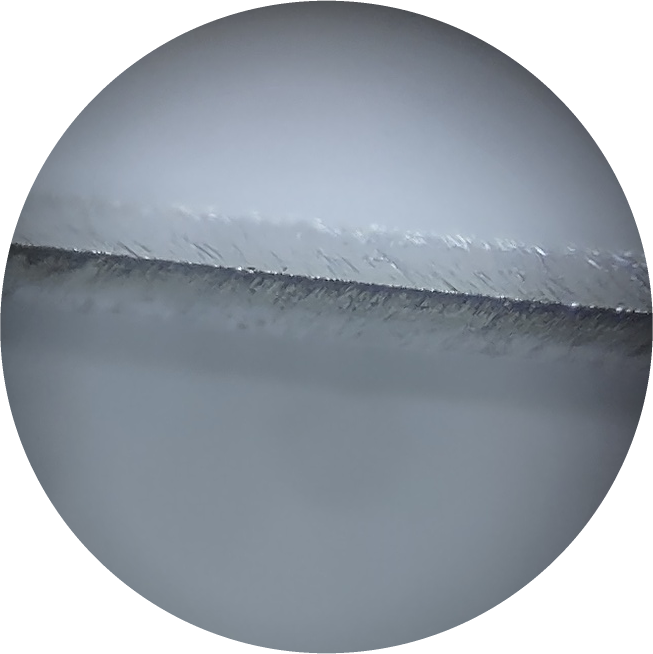I'm having difficulty learning to use a strop.
I can put an edge on most of my knives using diamond stones and a very fine ceramic stone. However, when I attempt to use a strop loaded with compound, I invariable dull the edge of the knife rather than making it sharper.
Example:
K55K knife, C75 carbon steel blade (supposedly similar to 1075)
15 degree bevel, tiny 20 degree secondary bevel
DMT Dia-Sharp diamond fine (25 micron) > Dia-Sharp extra fine (9 micron) > Norton Ascent ceramic ultra fine (~J8000)
The blade is sharp enough to very easily cut hair on my arm, and to cleanly push-cut copy paper width-wise.
Stropping with any of the following combinations only dulls the edge:
TechDiamondTools 3 micron diamond paste 50% concentration, on a suede strop
Sharpal green compound, purportedly ~1 micron chromium oxide, on a suede strop
Norton 1 micron diamond paste 50% concentration, on a suede strop
Kent Supplies 0.5 micron diamond paste 15% concentration, on a smooth strop
I'm clearly doing it wrong.
I am trying the minimal-pressure method. Stropping with the same angle I used on stones dulls the blade, even on a smooth strop.
I've read that I should find the right angle by slowly, carefully running the blade edge-first down the strop, starting with the blade laying flat, raising the spine just until the edge starts to catch / bite, then slightly reducing the angle. I've tried this but I'm unsure how much bite to target. Am I looking for the point where I just start to feel the slightest bit of strop texture being transmitted through the knife edge? Or the point where the edge begins to grab the texture? Or the point where the edge begins to grab the solid leather?
More importantly, what does it feel like when I'm stropping at the proper angle? Should the knife feel like it is smoothly sliding / gliding across the strop? Or should I just barely feel texture through the knife blade, the faint vibrations as the edge lightly caresses the surface texture of the strop? Or should I solidly feel the texture of the strop as the blade moves across it?
Thanks.
I can put an edge on most of my knives using diamond stones and a very fine ceramic stone. However, when I attempt to use a strop loaded with compound, I invariable dull the edge of the knife rather than making it sharper.
Example:
K55K knife, C75 carbon steel blade (supposedly similar to 1075)
15 degree bevel, tiny 20 degree secondary bevel
DMT Dia-Sharp diamond fine (25 micron) > Dia-Sharp extra fine (9 micron) > Norton Ascent ceramic ultra fine (~J8000)
The blade is sharp enough to very easily cut hair on my arm, and to cleanly push-cut copy paper width-wise.
Stropping with any of the following combinations only dulls the edge:
TechDiamondTools 3 micron diamond paste 50% concentration, on a suede strop
Sharpal green compound, purportedly ~1 micron chromium oxide, on a suede strop
Norton 1 micron diamond paste 50% concentration, on a suede strop
Kent Supplies 0.5 micron diamond paste 15% concentration, on a smooth strop
I'm clearly doing it wrong.
I am trying the minimal-pressure method. Stropping with the same angle I used on stones dulls the blade, even on a smooth strop.
I've read that I should find the right angle by slowly, carefully running the blade edge-first down the strop, starting with the blade laying flat, raising the spine just until the edge starts to catch / bite, then slightly reducing the angle. I've tried this but I'm unsure how much bite to target. Am I looking for the point where I just start to feel the slightest bit of strop texture being transmitted through the knife edge? Or the point where the edge begins to grab the texture? Or the point where the edge begins to grab the solid leather?
More importantly, what does it feel like when I'm stropping at the proper angle? Should the knife feel like it is smoothly sliding / gliding across the strop? Or should I just barely feel texture through the knife blade, the faint vibrations as the edge lightly caresses the surface texture of the strop? Or should I solidly feel the texture of the strop as the blade moves across it?
Thanks.



